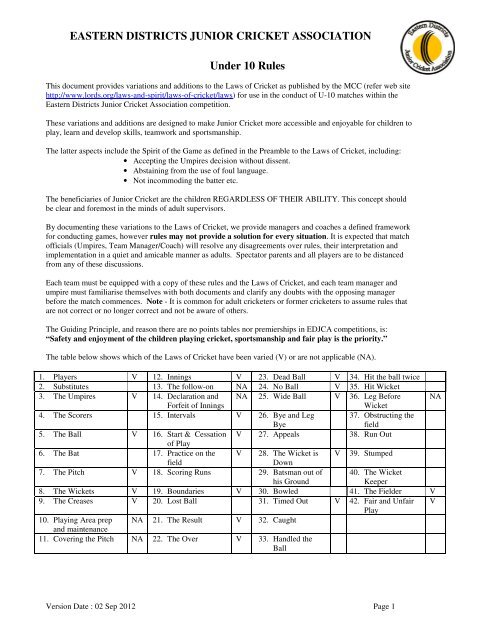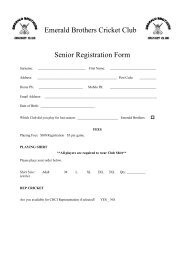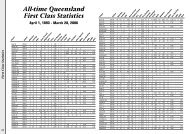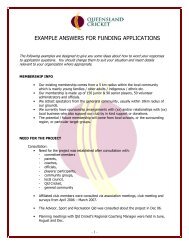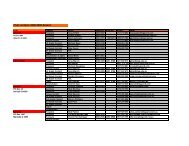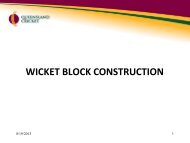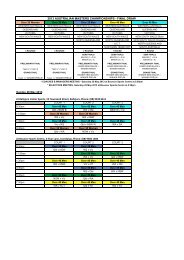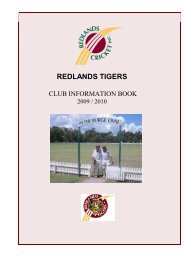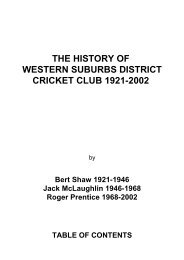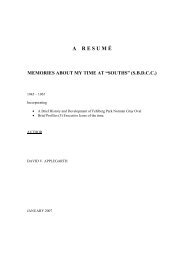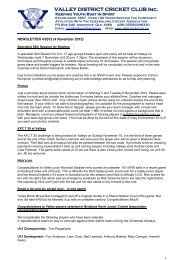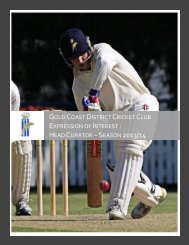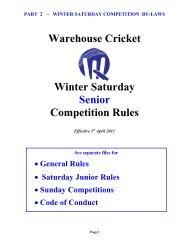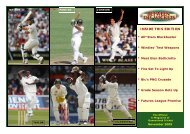Under 10 Rules in full - Queensland Cricket
Under 10 Rules in full - Queensland Cricket
Under 10 Rules in full - Queensland Cricket
You also want an ePaper? Increase the reach of your titles
YUMPU automatically turns print PDFs into web optimized ePapers that Google loves.
EASTERN DISTRICTS JUNIOR CRICKET ASSOCIATION<br />
<strong>Under</strong> <strong>10</strong> <strong>Rules</strong><br />
This document provides variations and additions to the Laws of <strong>Cricket</strong> as published by the MCC (refer web site<br />
http://www.lords.org/laws-and-spirit/laws-of-cricket/laws) for use <strong>in</strong> the conduct of U-<strong>10</strong> matches with<strong>in</strong> the<br />
Eastern Districts Junior <strong>Cricket</strong> Association competition.<br />
These variations and additions are designed to make Junior <strong>Cricket</strong> more accessible and enjoyable for children to<br />
play, learn and develop skills, teamwork and sportsmanship.<br />
The latter aspects <strong>in</strong>clude the Spirit of the Game as def<strong>in</strong>ed <strong>in</strong> the Preamble to the Laws of <strong>Cricket</strong>, <strong>in</strong>clud<strong>in</strong>g:<br />
• Accept<strong>in</strong>g the Umpires decision without dissent.<br />
• Absta<strong>in</strong><strong>in</strong>g from the use of foul language.<br />
• Not <strong>in</strong>commod<strong>in</strong>g the batter etc.<br />
The beneficiaries of Junior <strong>Cricket</strong> are the children REGARDLESS OF THEIR ABILITY. This concept should<br />
be clear and foremost <strong>in</strong> the m<strong>in</strong>ds of adult supervisors.<br />
By document<strong>in</strong>g these variations to the Laws of <strong>Cricket</strong>, we provide managers and coaches a def<strong>in</strong>ed framework<br />
for conduct<strong>in</strong>g games, however rules may not provide a solution for every situation. It is expected that match<br />
officials (Umpires, Team Manager/Coach) will resolve any disagreements over rules, their <strong>in</strong>terpretation and<br />
implementation <strong>in</strong> a quiet and amicable manner as adults. Spectator parents and all players are to be distanced<br />
from any of these discussions.<br />
Each team must be equipped with a copy of these rules and the Laws of <strong>Cricket</strong>, and each team manager and<br />
umpire must familiarise themselves with both documents and clarify any doubts with the oppos<strong>in</strong>g manager<br />
before the match commences. Note - It is common for adult cricketers or former cricketers to assume rules that<br />
are not correct or no longer correct and not be aware of others.<br />
The Guid<strong>in</strong>g Pr<strong>in</strong>ciple, and reason there are no po<strong>in</strong>ts tables nor premierships <strong>in</strong> EDJCA competitions, is:<br />
“Safety and enjoyment of the children play<strong>in</strong>g cricket, sportsmanship and fair play is the priority.”<br />
The table below shows which of the Laws of <strong>Cricket</strong> have been varied (V) or are not applicable (NA).<br />
1. Players V 12. Inn<strong>in</strong>gs V 23. Dead Ball V 34. Hit the ball twice<br />
2. Substitutes 13. The follow-on NA 24. No Ball V 35. Hit Wicket<br />
3. The Umpires V 14. Declaration and NA 25. Wide Ball V 36. Leg Before NA<br />
Forfeit of Inn<strong>in</strong>gs<br />
Wicket<br />
4. The Scorers 15. Intervals V 26. Bye and Leg 37. Obstruct<strong>in</strong>g the<br />
Bye<br />
field<br />
5. The Ball V 16. Start & Cessation<br />
of Play<br />
V 27. Appeals 38. Run Out<br />
6. The Bat 17. Practice on the V 28. The Wicket is V 39. Stumped<br />
field<br />
Down<br />
7. The Pitch V 18. Scor<strong>in</strong>g Runs 29. Batsman out of 40. The Wicket<br />
his Ground<br />
Keeper<br />
8. The Wickets V 19. Boundaries V 30. Bowled 41. The Fielder V<br />
9. The Creases V 20. Lost Ball 31. Timed Out V 42. Fair and Unfair<br />
Play<br />
V<br />
<strong>10</strong>. Play<strong>in</strong>g Area prep<br />
and ma<strong>in</strong>tenance<br />
NA 21. The Result V 32. Caught<br />
11. Cover<strong>in</strong>g the Pitch NA 22. The Over V 33. Handled the<br />
Ball<br />
Version Date : 02 Sep 2012 Page 1
1 Players and Teams<br />
1.1 Player Eligibility (Law 1 addition)<br />
A player is eligible to play <strong>in</strong> an under age team provided his age on 31st August, is under the aforesaid age group.<br />
Examples: Player is 9 or younger on 31st August and is eligible to play under <strong>10</strong>. Player turns <strong>10</strong> on or after 1st<br />
September is eligible to play under 11.<br />
Overage Players : Clubs may, on the written application to the Association, request to play an older player <strong>in</strong> a<br />
lower age group on the basis that it may be detrimental to or dangerous for that player if he participated <strong>in</strong> his own<br />
age group. Clubs will be notified of the players granted permission to play under this rule so that all players can<br />
monitor the progress of the player and report to the Association if deemed necessary. Permission will also be<br />
granted <strong>in</strong> the exceptional circumstances of need<strong>in</strong>g to make up the requisite numbers to form a team.<br />
Female players may play up to 2 years down <strong>in</strong> age grade (QCA policy). This allowance for female players is more<br />
a consideration <strong>in</strong> older age groups.<br />
Players may play up a grade at club level but not for EDJCA representative teams.<br />
All players must be registered with the club, be f<strong>in</strong>ancial and recorded <strong>in</strong> the my<strong>Cricket</strong> system before tak<strong>in</strong>g the<br />
field at tra<strong>in</strong><strong>in</strong>g or <strong>in</strong> matches. This is to ensure coverage by the QCA Insurance policy.<br />
1.2 Team Sizes (Law 1 variation)<br />
The preferred size of an <strong>Under</strong> <strong>10</strong> team is ten (<strong>10</strong>) players per team, and the maximum is twelve (12) players per<br />
team. All players <strong>in</strong> the team must bat and bowl where medically able.<br />
The m<strong>in</strong>imum number of players required for a team to play is seven (7). If one side is short of players, the other<br />
side should offer fielders to make a game.<br />
1.3 Player’s Cloth<strong>in</strong>g (Law 1 addition)<br />
a) All players are to wear white cloth<strong>in</strong>g, unless wear<strong>in</strong>g an approved club shirt<br />
b) All players are to wear footwear (preferably white) at all times while participat<strong>in</strong>g <strong>in</strong> a cricket game<br />
c) It is encouraged that all players wear sunscreen, a Sun Hat (preferably White) or a Club cap while field<strong>in</strong>g<br />
d) All cloth<strong>in</strong>g should not carry advertis<strong>in</strong>g, not approved by <strong>Queensland</strong> Junior <strong>Cricket</strong><br />
1.4 Players Equipment (Law 1 addition)<br />
a) When batt<strong>in</strong>g all batters must wear a Helmet, Batt<strong>in</strong>g gloves, Two (2) Pads and a Protector<br />
b) When Wicket keep<strong>in</strong>g, wicket keepers must wear a Helmet, wicket keep<strong>in</strong>g gloves, Two (2) Pads and a<br />
protector.<br />
c) All Helmets must be of the type approved by <strong>Cricket</strong> Australia.<br />
d) It is also recommended that a mouth guard be also worn.<br />
e) For hygiene it is recommended that players provide their own protector. Where club protectors are used then<br />
two sets of underwear should be used with the protector between.<br />
1.5 Responsibility for Behaviour (Law 1 clarification)<br />
It is the responsibility of the team manager/coach to both demonstrate compliance and ensure their players, parents<br />
and sibl<strong>in</strong>gs of players comply with the QCA code of conduct (refer to section 6) and the Spirit of the Game as<br />
def<strong>in</strong>ed <strong>in</strong> the Preamble to the Laws of <strong>Cricket</strong>. On-field behaviour will be governed by the umpires with<br />
assistance of team managers/coaches.<br />
2 The Umpires, Hours and Conditions of Play<br />
2.1 Appo<strong>in</strong>tment and Chang<strong>in</strong>g of Umpires (Law 3 variation)<br />
The team managers/coaches shall appo<strong>in</strong>t umpires for periods of play and may be changed at <strong>in</strong>tervals.<br />
EDJCA U<strong>10</strong> <strong>Rules</strong> v20120902.doc Page 2
All bowlers shall bowl from one end. The batters should change ends each over.<br />
It is suggested that the bowl<strong>in</strong>g team umpire the bowlers end and the batt<strong>in</strong>g team umpire at square leg so any<br />
coach<strong>in</strong>g for suspect bowl<strong>in</strong>g actions may be applied <strong>in</strong> a manner that does not delay the game.<br />
On-field coach<strong>in</strong>g by umpires is encouraged but should not delay the progress of the game.<br />
2.2 Doubtful Bowl<strong>in</strong>g Action (Law 3 addition - special condition)<br />
A bowler whom the Umpire(s) consider to have a doubtful bowl<strong>in</strong>g action is not to be called a no-ball.<br />
If the Umpire(s) consider a bowl<strong>in</strong>g action to be doubtful the Coach/Manager of the field<strong>in</strong>g team should be<br />
advised and the player coached towards corrective action.<br />
Where a manager/coach is aware of a doubtful bowl<strong>in</strong>g action prior to the game commenc<strong>in</strong>g they should advise<br />
the oppos<strong>in</strong>g manager/coach and umpires beforehand.<br />
The longer a player cont<strong>in</strong>ues to bowl with a doubtful action, the lower the chance of corrective action be<strong>in</strong>g<br />
effective, therefore it is <strong>in</strong> the players best <strong>in</strong>terests that clubs focus on bowl<strong>in</strong>g actions at tra<strong>in</strong><strong>in</strong>g.<br />
This rule is not provided to allow players to deliberately throw <strong>in</strong>stead of bowl<strong>in</strong>g. It is provided for player<br />
development and encouragement. It is consistent with BEARS rules govern<strong>in</strong>g the zone (U-13 to U-16).<br />
2.3 Conditions of Ground (Law 3 variation)<br />
The Team Managers shall <strong>in</strong>spect the field prior to the game commenc<strong>in</strong>g and satisfy themselves that it is fit for<br />
play. This must be recorded on the QCA standard form “Pre-Game Checklist”, signed by both managers and held<br />
by the home team.<br />
Play should only be suspended when the conditions are so bad (<strong>in</strong>clud<strong>in</strong>g lightn<strong>in</strong>g) that it is unreasonable or<br />
dangerous to cont<strong>in</strong>ue. A ground is unfit for play when it is so slippery so as to deprive batsmen or bowlers of a<br />
reasonable foothold, or the fieldsman freedom of movement.<br />
The Laws of <strong>Cricket</strong> state that “the fact that the grass and the ball are wet and slippery does not warrant the ground<br />
conditions be<strong>in</strong>g regarded as unreasonable or dangerous. However, if the umpires (team managers) consider the<br />
ground is so wet or slippery so as to deprive the bowler of a reasonable foothold, the fielders the power of<br />
movement, or the batters of the ability to play their strokes or to run between wickets, then these conditions shall<br />
be regarded as so bad that it would be unreasonable for play to take place.”<br />
2.4 Disagreement between umpires/managers over conditions (Law 3 clarification)<br />
Law 3 requires agreement of both umpires <strong>in</strong> respect of conditions. In EDJCA matches this is clarified as where<br />
disagreement arises regard<strong>in</strong>g play<strong>in</strong>g conditions then status quo prevails, ie:<br />
• if play is underway then play is to cont<strong>in</strong>ue until conditions change and umpires reach agreement;<br />
• if play is not underway then play rema<strong>in</strong>s suspended until conditions change and umpires reach<br />
agreement.<br />
2.5 Hours of Play (Law 3 addition)<br />
a) The hours of play are 8.00am to 11.30am – Three (3) hours and thirty (30) m<strong>in</strong>utes of play/game.<br />
b) If ra<strong>in</strong> <strong>in</strong>terrupts play, then reduce the match by one over per team for every Six (6) m<strong>in</strong>utes lost.<br />
c) Where the <strong>in</strong>n<strong>in</strong>gs of one team is shortened to meet the 11:30am f<strong>in</strong>ish time then the other side’s score will be<br />
taken as at the same number of overs completed <strong>in</strong> order to determ<strong>in</strong>e the match result. M<strong>in</strong>imum 13 overs per<br />
team required for a result.<br />
2.6 Inn<strong>in</strong>gs and Intervals (Laws 12 and 15 variation)<br />
a) All games are one-day games, of twenty-five (25) overs per team.<br />
b) Batters who are given out will rema<strong>in</strong> at the crease to complete their number of balls to be faced (see section<br />
2.8). Batter given out is to swap ends. There is no maximum number of wickets per <strong>in</strong>n<strong>in</strong>gs.<br />
EDJCA U<strong>10</strong> <strong>Rules</strong> v20120902.doc Page 3
c) Matches cont<strong>in</strong>ue to bowl out all overs (up to 11:30am) regardless of score.<br />
d) The game will be played <strong>in</strong> quarters with a <strong>10</strong> m<strong>in</strong>ute break <strong>in</strong> between quarters as follows:<br />
Q1: Team 1 bats for 13 overs; then<br />
Q2: Team 2 bats for 13 overs; then<br />
Q3: Team 1 resumes batt<strong>in</strong>g for its rema<strong>in</strong><strong>in</strong>g 12 overs; then<br />
Q4: Team 2 resumes batt<strong>in</strong>g for its rema<strong>in</strong><strong>in</strong>g 12 overs.<br />
2.7 Bowl<strong>in</strong>g Limits – Number of Overs (Law 3 addition – special conditions)<br />
All players are to bowl a m<strong>in</strong>imum of Two (2) overs each. The coach of the bowl<strong>in</strong>g side will elect the player(s)<br />
who are to bowl an extra over each, so as to make up the 25 overs. To ensure all players receive equal bowl<strong>in</strong>g<br />
opportunities, no bowler is to bowl a 4 th over until all players on that team have bowled 3 overs.<br />
This will require a change of wicket keeper dur<strong>in</strong>g the match. It is suggested this be performed at a change of<br />
Quarter.<br />
The Team’s Bowl<strong>in</strong>g order should be rotated each match to ensure all have a chance to bowl with a new and old<br />
ball.<br />
2.8 Batt<strong>in</strong>g Limits – Number of Balls Faced (Law 3 addition – special conditions)<br />
Batt<strong>in</strong>g limits are provided to ensure all batters face equal numbers of balls per batt<strong>in</strong>g pair irrespective of number<br />
of dismissals.<br />
The number of balls is calculated by divid<strong>in</strong>g 150 (i.e. 25 overs) by the number of players <strong>in</strong> the team. The last 2<br />
batters share the extra balls if not evenly divisible. Scorers are required to assist umpires to ensure the correct<br />
number of balls are faced by each batter and to change a batter when the number balls for that <strong>in</strong>dividual batter has<br />
been reached, except for the last pair where scorer advises umpire for striker to swap ends when faced their share<br />
of balls.<br />
Balls Faced means all deliveries <strong>in</strong>clud<strong>in</strong>g Wides and No balls.<br />
The Team’s Batt<strong>in</strong>g order should be rotated each match to ensure all have a chance to bat <strong>in</strong> various positions <strong>in</strong><br />
the order.<br />
2.9 Fielder Limits – Number and Placement (Law 41 Variation)<br />
a) A maximum of ten (<strong>10</strong>) players from the field<strong>in</strong>g team may be on the field at any one period of time.<br />
b) Where there are more than (<strong>10</strong>) on a team, the coach is to rotate the players on and off the field between overs,<br />
giv<strong>in</strong>g all players an equal field<strong>in</strong>g time dur<strong>in</strong>g the game.<br />
c) The field<strong>in</strong>g side may have no more than four fielders on either side of the wicket, plus bowler and wicketkeeper,<br />
otherwise “No Ball”. No long-stops, however f<strong>in</strong>e leg is permitted.<br />
d) No fielder shall be with<strong>in</strong> <strong>10</strong> metres of the striker at time of delivery, except <strong>in</strong> the wicket keeper/slips area.<br />
May Field <strong>in</strong> this<br />
Area<br />
Po<strong>in</strong>t<br />
Wicketkeeper<br />
o o o<br />
<strong>10</strong> metres<br />
Right Hand Batsman<br />
Not to field <strong>in</strong> this<br />
Area<br />
Not to field <strong>in</strong> this<br />
Area<br />
Wicketkeeper<br />
<strong>10</strong> metres<br />
EDJCA U<strong>10</strong> <strong>Rules</strong> v20120902.doc Page 4<br />
o o o<br />
Left Hand Batsman<br />
2.<strong>10</strong> Balls (Law 5 Variation)<br />
The balls used for <strong>Under</strong> <strong>10</strong> are 1<strong>10</strong>g Soft-a-ball, eg. Kookaburra, Platypus or Gabba.<br />
May Field <strong>in</strong> this<br />
Area<br />
Po<strong>in</strong>t
2.11 Pitch, Wickets and Creases (Laws 7, 8 and 9 variations)<br />
a) The pitch is to be shortened to eighteen (18) metres <strong>in</strong> length. The width is as provided.<br />
b) The use of freestand<strong>in</strong>g stumps at both ends is needed to achieve the lesser distance – place the stumps on the<br />
normal batt<strong>in</strong>g creases and use chalk to mark the new batt<strong>in</strong>g creases (unless already marked).<br />
c) The batters are to bat from one end only. The batters are to rotate at the end of each over.<br />
d) The batters run to the shortened marked batt<strong>in</strong>g crease.<br />
e) The crease at the batt<strong>in</strong>g end is to have “Centre” marked. (Centre be<strong>in</strong>g the mark on the strikers batt<strong>in</strong>g crease<br />
that depicts the l<strong>in</strong>e from the centre stump at the strikers end to the centre stump at the bowlers end).<br />
f) All batters are to take guard (face up) with their bat on the centre mark or towards the leg side each time they<br />
take strike. Where a batter faces up with the bat further to the offside of the Centre stump, the umpire is<br />
required to move the batter over so he/she takes guard on Centre or towards the leg stump. This is to allow the<br />
bowler a “fair go” <strong>in</strong> the light of LBW not apply<strong>in</strong>g.<br />
2.12 Practice on the field (Law 17 variation)<br />
Practice outside the play<strong>in</strong>g area is allowed, however limits apply <strong>in</strong> terms of distract<strong>in</strong>g batters and <strong>in</strong>trud<strong>in</strong>g on<br />
the field with practice balls.<br />
2.13 Boundaries (Law 19 variation)<br />
Field boundaries are a circle of a maximum of 35 metres from the centre of the pitch will apply for all matches<br />
played <strong>in</strong> the <strong>Under</strong> <strong>10</strong> competition. This is to encourage straight shots. Boundaries may be reduced by agreement<br />
between team managers where long grass prohibits free-runn<strong>in</strong>g of the ball.<br />
The boundary is to be clearly def<strong>in</strong>ed, preferably by use of boundary markers. Where a boundary is not marked<br />
with a cont<strong>in</strong>uous l<strong>in</strong>e and boundary markers are placed at <strong>in</strong>tervals, the boundary is def<strong>in</strong>ed as a straight l<strong>in</strong>e<br />
between markers (not an arc). Players and parent umpires must be rem<strong>in</strong>ded of this by the managers before play.<br />
It is recommended that the measured length of rope or str<strong>in</strong>g be used to measure the boundaries where necessary.<br />
3 The Result (Law 21 variation)<br />
The result of the match will be determ<strong>in</strong>ed on the highest average based on runs divided by wickets lost.<br />
The emphasis is on enjoy<strong>in</strong>g the game, good performances and fun moments rather than who won or lost.<br />
4 Bowl<strong>in</strong>g<br />
4.1 The Over (Law 22 variation)<br />
Over is to be called after Six (6) deliveries <strong>in</strong>clud<strong>in</strong>g Wides and No Balls.<br />
Wides and No-Balls are not re-bowled but are scored aga<strong>in</strong>st bowler and sundries. Runs off a no-ball are scored to<br />
the batter.<br />
Refer rule on 2.7 on bowl<strong>in</strong>g limits and 2.8 on batt<strong>in</strong>g limits.<br />
4.2 Dead Ball (Law 23 addition)<br />
A ball that behaves erratically of a crack or an obstacle on the pitch, or from the edge of the pitch, the ball is called<br />
dead and cannot take a wicket. The ball is to be re-bowled.<br />
A ball fail<strong>in</strong>g to reach the batsman is to be called a dead ball and the ball re-bowled.<br />
4.3 No Ball (Law 24)<br />
The follow<strong>in</strong>g are from the Laws of <strong>Cricket</strong> (Law 24 and relevant sections of Law 42):<br />
a) Where the bowler over steps the popp<strong>in</strong>g (front crease) at the bowl<strong>in</strong>g end.<br />
b) Where the ball bounces more than twice or rolls before reach<strong>in</strong>g the strikers stumps.<br />
c) From 42.6 a) Either umpire can call a no ball where a short pitched fast delivery lands on the pitch and<br />
bounces above the batter’s shoulder height when stand<strong>in</strong>g <strong>in</strong> a normal batt<strong>in</strong>g stance. Common sense is to<br />
prevail <strong>in</strong> decid<strong>in</strong>g what is a short pitched fast delivery as the paramount issue is the safety of the batter.<br />
EDJCA U<strong>10</strong> <strong>Rules</strong> v20120902.doc Page 5
d) A Player cannot be out bowled, caught, hit wicket nor stumped off a no-ball. However the batter can be given<br />
out run out if attempt<strong>in</strong>g a run, obstruct<strong>in</strong>g the field, hit the ball twice, handled the ball.<br />
e) No-ball overrides a Wide.<br />
Variation to Law 24 (as it refers to Law 42.6 b) – Dangerous and Unfair Bowl<strong>in</strong>g:<br />
• Any <strong>full</strong> pitched delivery delivered by any bowler and directed at the batter above waist height when<br />
stand<strong>in</strong>g <strong>in</strong> a normal batt<strong>in</strong>g stance shall be called" No Ball” and can be called by either umpire.<br />
Variation to Law 24 – Fair Delivery : Doubtful Bowl<strong>in</strong>g Action is not to be called – refer section 2.2<br />
Variation to Law 24 – Counts as ball <strong>in</strong> the over : No-balls are not re-bowled.<br />
4.4 Wide Ball (Law 25)<br />
A wide as per the Laws of <strong>Cricket</strong> is:<br />
a) a ball that does not hit the designated pitch, or<br />
b) hits the pitch but passes the strikers wicket outside the edge of the designated pitch or<br />
c) is not <strong>in</strong> reach of striker at the crease (eg. bounces too high or too wide to reach).<br />
Where a batter hits a wide ball or the batter is struck by the wide ball, normal cricket rules apply (ie. is no longer a<br />
wide).<br />
Batter can only be out hit wicket, handled the ball, obstruct<strong>in</strong>g the field, stumped or run out off a wide.<br />
Variation to Law 25 – Counts as ball <strong>in</strong> the over : Wides are not re-bowled.<br />
4.5 Fair and Unfair Play (Law 42)<br />
Variation to Law 42.6 b) – Dangerous and Unfair Bowl<strong>in</strong>g:<br />
• Any <strong>full</strong> pitched delivery delivered by any bowler and directed at the batter above waist height when<br />
stand<strong>in</strong>g <strong>in</strong> a normal batt<strong>in</strong>g stance shall be called" No Ball” and can be called by either umpire<br />
Variation to Law 42.15 : Runn<strong>in</strong>g out non-striker before delivery (aka Mankad) are not permitted. The umpire is<br />
to call Dead Ball and warn the non-striker to rema<strong>in</strong> <strong>in</strong> their crease until the bowler bowls.<br />
5 Batt<strong>in</strong>g<br />
5.1 The Wicket is Down (Law 28 variation)<br />
As <strong>Under</strong> <strong>10</strong> cricket use freestand<strong>in</strong>g metal stumps, there are no bails to remove to <strong>in</strong>dicate the wicket is down.<br />
It is the sole judgement of the umpires as to whether the wicket has been struck by the ball or, as applicable, the<br />
hand hold<strong>in</strong>g the ball <strong>in</strong> order to be down.<br />
5.2 Timed Out (Law 31 variation)<br />
The Timed Out law will be only apply if the batter concerned is absent from the field or refuses to take the field.<br />
5.3 Leg Before Wicket - LBW (Law 36 does not apply)<br />
In <strong>Under</strong> <strong>10</strong> cricket “LBW” decisions will not apply<br />
Where a batter does not offer a shot or <strong>in</strong>tentionally places his/her pads <strong>in</strong> front of the stumps to stop be<strong>in</strong>g bowled,<br />
then he/she should be counselled by the umpire at the bowlers end and by the batters team’s manager/coach.<br />
EDJCA U<strong>10</strong> <strong>Rules</strong> v20120902.doc Page 6
6 QCA Code of Conduct<br />
Players<br />
• Play by the rules.<br />
• Never argue with an umpire. If you disagree, have<br />
your capta<strong>in</strong>, coach or manager, approach the<br />
umpire dur<strong>in</strong>g a break or after the game.<br />
• Control your temper. Verbal abuse of officials and<br />
sledg<strong>in</strong>g other players, deliberately distract<strong>in</strong>g or<br />
provok<strong>in</strong>g an opponent are not acceptable or<br />
permitted behaviours <strong>in</strong> cricket.<br />
• Work equally hard for yourself and your team<br />
mates. Your team’s performance will benefit and so<br />
will you.<br />
• Be a good sport. Applaud all good plays whether<br />
they are made by your team or the opposition.<br />
• Treat all participants <strong>in</strong> cricket as you like to be<br />
treated. Do not bully of take unfair advantage of<br />
another competitor.<br />
• Cooperate with your coach, team mates and<br />
opponents. Without them there would be no<br />
competition.<br />
• Participate for your own enjoyment and benefit, not<br />
just to please parents and coaches.<br />
• Respect the rights, dignity and worth of every<br />
young person regardless of their gender, ability,<br />
cultural background or religion.<br />
Parents<br />
• Do not force an unwill<strong>in</strong>g child to participate <strong>in</strong><br />
cricket.<br />
• Remember, children are <strong>in</strong>volved <strong>in</strong> cricket for<br />
their enjoyment, not yours.<br />
• Encourage your child to play by the rules.<br />
• Focus on the child’s efforts and performance rather<br />
than w<strong>in</strong>n<strong>in</strong>g or los<strong>in</strong>g.<br />
• Never ridicule or yell at a child for mak<strong>in</strong>g a<br />
mistake or los<strong>in</strong>g a game.<br />
• Remember that children learn best by example.<br />
• Appreciate good performances and skilful plays by<br />
all participants.<br />
• Support all efforts to remove verbal and physical<br />
abuse from sport<strong>in</strong>g activities.<br />
• Respect officials’ decisions and teach children to<br />
do likewise.<br />
• Show appreciation for volunteer coaches, officials<br />
and adm<strong>in</strong>istrators. Without them, your child could<br />
not participate.<br />
• Respect the rights, dignity and worth of every<br />
young person regardless of their gender, ability,<br />
cultural background or religion.<br />
EDJCA U<strong>10</strong> <strong>Rules</strong> v20120902.doc Page 7
Coaches<br />
• Remember that young people participate for<br />
pleasure and w<strong>in</strong>n<strong>in</strong>g is only part of the fun.<br />
• Never ridicule or yell at a young player for mak<strong>in</strong>g<br />
a mistake or not com<strong>in</strong>g first.<br />
• Be reasonable <strong>in</strong> your demands on players’ time,<br />
energy and enthusiasm.<br />
• Operate with<strong>in</strong> the rules and Spirit of <strong>Cricket</strong> and<br />
teach your players to do the same.<br />
• Ensure that the time players spend with you is a<br />
positive experience.<br />
• Avoid overplay<strong>in</strong>g the talented players; all young<br />
players need and deserve equal time, attention and<br />
opportunities.<br />
• Ensure that equipment and facilities meet safety<br />
standards and are appropriate to the age and ability<br />
of all players.<br />
• Display control and respect to all those <strong>in</strong>volved <strong>in</strong><br />
cricket. This <strong>in</strong>cludes opponents, coaches, umpires,<br />
adm<strong>in</strong>istrators, parents and spectators. Encourage<br />
your players to do the same.<br />
• Show concern and caution toward sick and <strong>in</strong>jured<br />
players.<br />
• Follow the advice of a physician when determ<strong>in</strong><strong>in</strong>g<br />
whether an <strong>in</strong>jured player is ready to recommence<br />
tra<strong>in</strong><strong>in</strong>g or competition.<br />
• Obta<strong>in</strong> appropriate qualifications and keep up to<br />
date with the latest cricket coach<strong>in</strong>g practices and<br />
pr<strong>in</strong>ciples of growth and development of young<br />
people.<br />
• Any physical contact with a young person should<br />
be appropriate to the situation and necessary for the<br />
player’s skill development.<br />
• Respect the rights, dignity and worth of every<br />
young person regardless of their gender ability,<br />
cultural background or religion.<br />
Umpires<br />
• Place the safety and welfare of participants above<br />
all else.<br />
• In accordance with <strong>Cricket</strong> Australia guidel<strong>in</strong>es,<br />
modify rules and regulations to match the skill<br />
levels and needs of young people.<br />
• Compliment and encourage all participants.<br />
• Be consistent, objective and courteous when<br />
mak<strong>in</strong>g decisions.<br />
• Condemn unsport<strong>in</strong>g behaviour and promote<br />
respect for all opponents.<br />
• Emphasise the spirit of the game rather than the<br />
errors.<br />
• Encourage and promote rule changes which will<br />
make participation more enjoyable.<br />
• Be a good sport yourself - actions speak louder<br />
than words.<br />
• Keep up to date with the latest available resources<br />
for umpir<strong>in</strong>g and the pr<strong>in</strong>ciples of growth and<br />
development of young people.<br />
• Remember, you set an example. Your behaviour<br />
and comments should be positive and supportive.<br />
• Give all young people a ‘fair go’ regardless of their<br />
gender, ability, cultural background or religion.<br />
EDJCA U<strong>10</strong> <strong>Rules</strong> v20120902.doc Page 8


